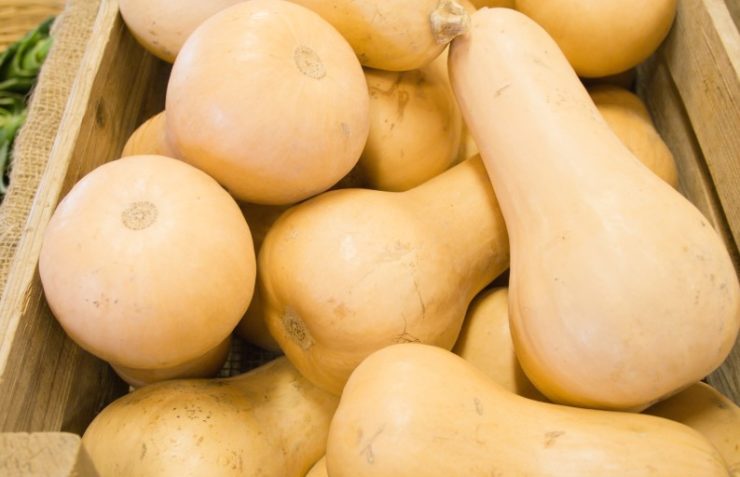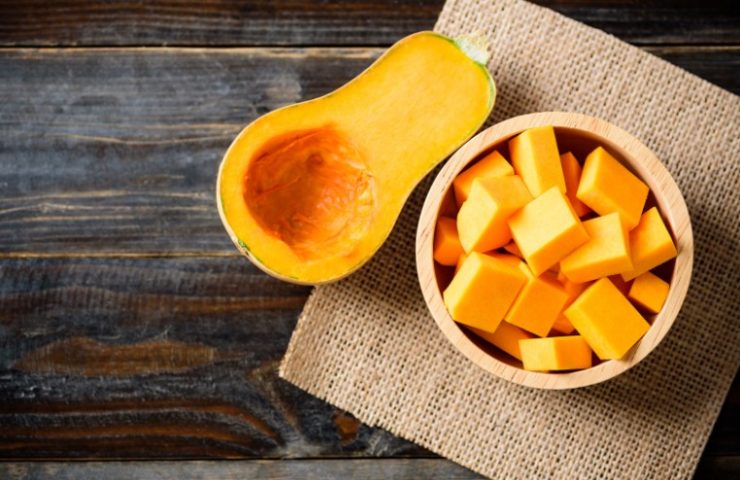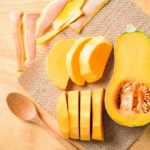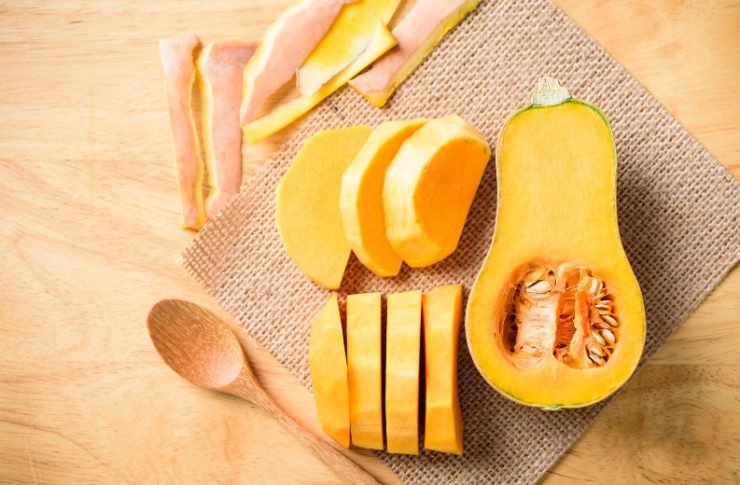Who doesn’t want a steaming bowl of smooth and silky butternut squash soup? Or delicate pillows of roasted squash in a spicy and creamy curry? But sometimes, peeling winter squash can seem like an incredibly daunting task.
However, if you have the right equipment and just a little know-how, peeling butternut squash can be done in no time.
Through my time in culinary school and professional kitchens, I’ve prepped my fair share of winter squash (and then some). In this article, I’ll teach you all the tips and tricks I know to make preparing butternut squash a breeze.
In This Article
How To Peel Butternut Squash Safely & Simply
What You’ll Need To Get Started:
- A stable cutting board
- A sharp chef knife
- A Y-Peeler with a swivel blade
- A clean, whole butternut squash
Time To Prep

First, ensure that your cutting board is stable on your countertop or table. A stabilized workspace is essential for working safely with tough-to-cut vegetables like butternut squash.
Place a damp but wrung-out paper towel under your cutting board to keep it from slipping and sliding. Or, use a piece of rubber grip mat which is something I always keep on hand in my kitchen.
Then, place your cleaned and dried butternut squash on the cutting board and use your knife to slice off a ¼-inch sliver from the top and bottom of the squash.

Pro-Tip: You can microwave the whole squash for about 30 seconds beforehand to help loosen up the peel. It will make peeling easier without changing the texture of the flesh.
Now, you can either stand the squash upright or lay it on its side and hold it firmly with your non-dominant hand.
With the y-peeler in your dominant hand, drag it from the top of the butternut squash to the bottom, lifting off slivers of peel as you go.
Continue removing strips of peel from around the entirety of the squash. And since you’ve already cut off the top and bottom, you should have an easy time getting your peeler under the skin for each pass.
Do I Have To Use A Vegetable Peeler?

It’s easiest and safest to peel the squash with a vegetable peeler rather than trying to use your chef’s knife.
Trying to cut into a tough vegetable, like butternut squash, with a cumbersome knife can lead to injury. Or, at the very least, gauging out and wasting too much of the squash when trying to remove just the peel.
Y-peelers have a double blade perpendicular to the handle in the shape of a “Y.” These are best for peeling long, straight vegetables like butternut squash or carrots.
The swivel blade will allow the peeler to follow the curves and contours of the squash. This allows you to remove the peel while keeping the most amount of squash intact as possible.
They’re also more comfortable to hold when trying to peel larger vegetables than a traditional peeler which I prefer to use for smaller, handheld produce.
I’ve Peeled The Squash. Now What?
After you peel your butternut squash, slice it in half longways.
Once split, you’ll find all of the seeds located in the bulbous end of the gourd. Use a spoon to scrape out all the seeds and discard them.
Then, you are free to slice or dice the squash to your desired shape and thickness.

Pro-Tip: Instead of discarding the seeds, rinse them in a colander, then coat with some oil, and season with whatever spices you’re in the mood for. Then, spread them in a single layer and roast them until they are crunchy and perfect for snacking.
How To Pick The Best Butternut Squash At The Store
The best tip that I have for picking out butternut squash at the store is to grab one that feels surprisingly heavy for its size. You’ll end up with a whole bunch of meat and a small seed cavity.
Similarly, you could opt for a squash with a longer neck and a smaller bulb. The entire neck will be meat, and you’re visually choosing a small seed cavity.
Look for squash with smooth, unblemished, beige-colored skin. You don’t want to pick one with brown spots, soft spots, indentations, or punctures. Surface scratches are perfectly fine, but you don’t want to bring home anything with deep gauges.
Tips for Storing Butternut Squash
Whole Squash

You should store butternut squash in a dark, cool place. If you’re lucky enough to have a root cellar, that would be where you want to keep them. For the rest of us, a basket on the counter or in a pantry or cupboard will do.
If a squash starts to go bad, remove it from other stored squash immediately to prevent the other squash from rotting.

Pro-Tip: Keep your squash away from fruits like apples or pears. These fruits release ethylene gas which will cause your squash to start breaking down and rotting more quickly.
Don’t store your whole butternut squash in the fridge, as it can negatively affect the texture of your squash. Not to mention the fact that they can take up so much refrigerator real estate.
Peeled or Cut Squash

Peeled or cut squash can be stored in a close-fitting, air-tight container or reusable freezer bag for up to 4 days in the fridge.
Alternatively, you can freeze cut-up raw, blanched, or cooked butternut squash in the freezer for about 4 to 6 months.
To freeze, spread out the cut or cooked pieces of butternut squash on a parchment-lined sheet pan and place them in the freezer. Once the cubes or slices are frozen, you can transfer them to a resealable freezer bag, and they won’t stick together.
If you want to store your butternut squash for longer than 4 to 6 months, it will benefit from being blanched first.
So, you’ll want to plunge your peeled and cubed squash into a pot of boiling water for about 15 seconds. Then, immediately remove and transfer to a bowl of ice water to stop the cooking process.
This quick dip in boiling water will kill the enzymes that contribute to the degradation of flavor in the squash over an extended period.
Frequently Asked Questions
Do you have to peel butternut squash before cooking it?
Butternut squash peels are edible, so you technically don’t have to remove them. However, the skin can be tough, which is why it’s commonly removed. Alternatively, you can roast unpeeled butternut squash halves and scoop out the soft, cooked flesh.
How can you soften butternut squash before cutting?
To soften butternut squash before cutting, try microwaving it for about 30 seconds. This isn’t long enough to cook the squash or change its texture, but it can soften it just enough to make peeling and cutting easier.
Can you eat the skin of butternut squash?
Technically, butternut squash skin is edible. All winter squash have edible skin, but most people don’t like the tough texture of the peel and will remove it.

How To Peel Butternut Squash
- Total Time: 5 minutes
- Yield: 1 medium-sized squash (about 3lbs) yields 4½ cups uncooked 1-inch cubes 1x
Description
Learn how to peel a butternut squash in a simple, fast, and efficient way.
Ingredients
- 1 Clean Butternut Squash
Instructions
- Place a cleaned and dried butternut squash on a stabilized cutting board.
- Slice off ¼ inch from each end of the squash.
- Drag a vegetable peeler from the top of the squash to the bottom, removing the peel.
- Continue removing ribbons of peel from the entirety of the squash.
- Then, split the squash lengthwise and scoop out the seeds from the cavity inside the bulbous end.
- Prep Time: 5 minutes
- Category: Knife Skills
- Cuisine: Any
Keywords: how to remove the skin from butternut squash, how to peel squash







